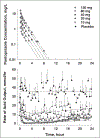Proton pump activation in stimulated parietal cells is regulated by gastric acid secretory capacity: a human study
- PMID: 12017345
- PMCID: PMC6719691
- DOI: 10.1177/00912700222011562
Proton pump activation in stimulated parietal cells is regulated by gastric acid secretory capacity: a human study
Abstract
Under normal physiological conditions, gastric acid production is controlled by a negative feedback mechanism. Proton pump inhibitors, such as pantoprazole, inhibit gastric acid secretion by irreversibly binding and inactivating luminally active hydrogen potassium ATPase. Recovery of acid production after treatment with a proton pump inhibitor is driven by new pump synthesis, activation of existing cytoplasmic pumps, or reversal of proton pump inhibition. The authors measured the time course of the inhibition and recovery of acid secretion in healthy volunteers following intravenous administration of pantoprazole to determine the rate of proton pump activation under maximally stimulated conditions. Gastric acid production was measured in 27 Helicobacter pylori negative healthy volunteers (mean age = 31 +/- 7 years; 17 men, 10 women) who received single doses of intravenous pantoprazole (20, 40, 80, or 120 mg) in the presence of a continuous intravenous infusion of 1 ug/kg/h of pentagastrin. From the time profile of acid secretion, the authors described the rate of change of acid output using an irreversible pharmacodynamic response model represented by the equation dR/dt = -k x R x Cpanto + Ln2/PPR x (Ro-R) and correlated the parameter values with demographic factors and gastric acid measurements. Mean stimulated acid output secretion was 21.6 +/- 18.4 mEq/h (range: 1.6-90.5) prior to the administration of pantoprazole and remained steady for 25 hours after placebo administration. Intravenous pantoprazole inhibited acid output in a dose-response fashion, with maximal inhibition (99.9%) occurring after an 80 mg dose. Mean proton pump recovery time was 37.1 +/- 21.0 hours (range: 6.7-75), and recovery was independent of the dose of pantoprazole. There was no association noted between proton pump recovery time and gender, age, race, body weight, or pantoprazole dose. However, there was an inverse correlation between acid output during baseline stimulation and recovery of acid secretion. Mean proton pump recovery time in stimulated normal human volunteers was 37.1 +/- 21.0 hours, with a range of 6.7 to 75 hours. The authors hypothesize that there may be a normal homeostatic mechanism that maintains acid secretory capability within a normal range by altering the rate of proton pump activation dependent on the individual's parietal cell mass. Abnormalities of this process may be responsible for the development of acid peptic disease in susceptible individuals.
Figures




Similar articles
-
Inhibition of pentagastrin-stimulated gastric acid secretion by pantoprazole and omeprazole in healthy adults.Dig Dis Sci. 2006 Jan;51(1):123-31. doi: 10.1007/s10620-006-3096-0. Dig Dis Sci. 2006. PMID: 16416224 Clinical Trial.
-
Inhibition of pentagastrin-induced gastric acid secretion by intravenous pantoprazole: a dose-response study.Am J Gastroenterol. 1999 Oct;94(10):2874-80. doi: 10.1111/j.1572-0241.1999.01430.x. Am J Gastroenterol. 1999. PMID: 10520836 Clinical Trial.
-
Pharmacodynamic modeling of pantoprazole's irreversible effect on gastric acid secretion in humans and rats.J Clin Pharmacol. 2001 Feb;41(2):149-56. doi: 10.1177/00912700122009953. J Clin Pharmacol. 2001. PMID: 11210394 Clinical Trial.
-
Continuing development of acid pump inhibitors: site of action of pantoprazole.Aliment Pharmacol Ther. 1994;8 Suppl 1:11-23. doi: 10.1111/j.1365-2036.1994.tb00211.x. Aliment Pharmacol Ther. 1994. PMID: 7514042 Review.
-
Review article: the continuing development of proton pump inhibitors with particular reference to pantoprazole.Aliment Pharmacol Ther. 1995 Aug;9(4):363-78. doi: 10.1111/j.1365-2036.1995.tb00394.x. Aliment Pharmacol Ther. 1995. PMID: 8527612 Review.
Cited by
-
A Case of Severe Proton Pump Inhibitor-Induced Hypomagnesemia Refractory to Continuous Oral and Intravenous Magnesium Replenishment.Cureus. 2024 Feb 19;16(2):e54483. doi: 10.7759/cureus.54483. eCollection 2024 Feb. Cureus. 2024. PMID: 38516446 Free PMC article.
-
Comparative anti-ulcerogenic study of pantoprazole formulation with and without sodium bicarbonate buffer on pyloric ligated rat.J Pharmacol Pharmacother. 2011 Jul;2(3):179-84. doi: 10.4103/0976-500X.83283. J Pharmacol Pharmacother. 2011. PMID: 21897712 Free PMC article.
-
Delayed release dexlansoprazole in the treatment of GERD and erosive esophagitis.Clin Exp Gastroenterol. 2009;2:117-28. doi: 10.2147/ceg.s5765. Epub 2009 Nov 17. Clin Exp Gastroenterol. 2009. PMID: 21694835 Free PMC article.
-
Proton pump inhibitors for the treatment of patients with erosive esophagitis and gastroesophageal reflux disease: current evidence and safety of dexlansoprazole.Clin Exp Gastroenterol. 2016 Jul 13;9:163-72. doi: 10.2147/CEG.S91602. eCollection 2016. Clin Exp Gastroenterol. 2016. PMID: 27471402 Free PMC article. Review.
-
Three-year oral pantoprazole administration is effective for patients with Zollinger-Ellison syndrome and other hypersecretory conditions.Aliment Pharmacol Ther. 2006 Feb 1;23(3):437-44. doi: 10.1111/j.1365-2036.2006.02762.x. Aliment Pharmacol Ther. 2006. PMID: 16423003 Free PMC article. Clinical Trial.
References
-
- Modlin IM, Sachs G: The regulation of acid secretion, in: Modlin IM, Sachs G (eds.), Acid Related Diseases: Biology and Treatment Konstanz, Germany: Schnetztor-Verlag, 1998;37–112.
-
- Modlin IM, Sachs G: The production of acid in the stomach, in: Modlin IM, Sachs G (eds.), Acid Related Diseases: Biology and Treatment Konstanz, Germany: Schnetztor-Verlag, 1998;1–36.
-
- Stewart B, Wallmark B, Sachs G: The interactions of H+ and K+ with the parietal reactions of gastric H,K-ATPase. J Biol Chem 1981; 256:2682–2690. - PubMed
-
- Fellenius E, Berglindh T, Sachs G, et al.: Substituted benzimidazoles inhibit gastric acid secretion by blocking (H+-K+)ATPase. Nature 1981;290:159–161. - PubMed
Publication types
MeSH terms
Substances
Grants and funding
LinkOut - more resources
Full Text Sources
Research Materials

